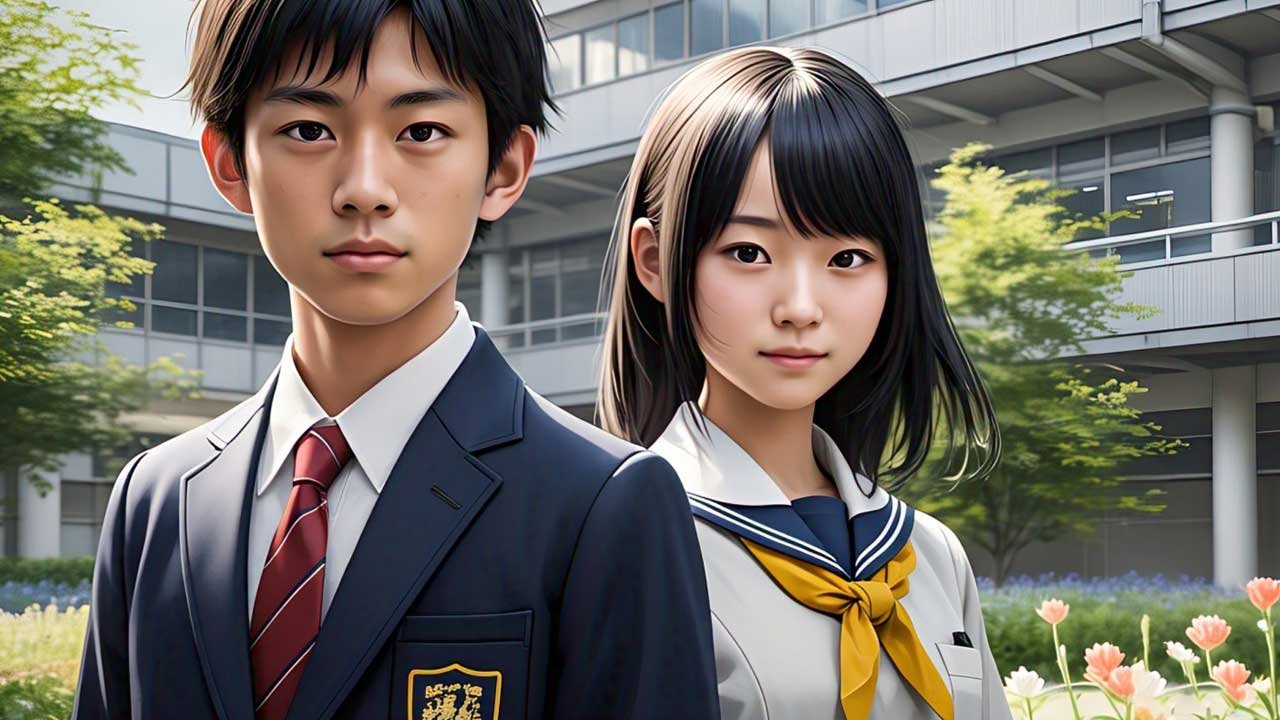In Japan, education typically begins with optional daycare or kindergarten from ages 0–5, followed by 9 years of compulsory education: 6 years of elementary school (ages 6–12) and 3 years of junior high school (ages 12–15). While senior high school (ages 15–18) is not mandatory, nearly all students attend.
After that, students may pursue higher education through universities, junior colleges, or vocational schools, with postgraduate options like master’s and doctoral programs. The system emphasizes academic discipline, moral education, and social responsibility, with a standardized national curriculum and a strong culture of after-school learning through “juku” (cram schools).
Navigating the Ascending Path of Knowledge: Understanding Japan’s Education System
Japan boasts a meticulously structured and highly standardized education system that plays a pivotal role in shaping its disciplined and academically proficient society. Characterized by a strong emphasis on diligence, scholarly excellence, and the comprehensive development of individuals, the Japanese educational journey unfolds systematically from early childhood to advanced studies. Let’s delve into a detailed, age-wise breakdown of this compelling system.
👶 Early Foundations: Nurturing Growth (Ages 0-5)
The initial years in Japan lay the groundwork for future learning and social integration.
Ages 0–2: Infant Care / Daycare (Hoikuen): While not compulsory, Hoikuen (保育園), or daycare centers, provide essential care and early stimulation for infants and toddlers, particularly catering to the needs of working parents. These facilities focus on creating a safe and nurturing environment, fostering basic social interactions, and supporting early developmental milestones through play and simple activities. The curriculum, though informal, emphasizes sensory exploration, language development through songs and stories, and the development of fine and gross motor skills.
Ages 3–5: Kindergarten (Yōchien / Hoikuen): Preschool education becomes more structured at this stage, offered through both Yōchien (幼稚園) (kindergarten, primarily focused on education) and Hoikuen (which also includes an educational component for this age group). The emphasis shifts towards developing crucial social skills such as cooperation, sharing, and respect for others. Basic learning concepts are introduced through playful activities, including art, music, physical education, and rudimentary literacy and numeracy skills. Field trips to local parks or community centers are common, fostering a connection with the outside world.
🎒 The Compulsory Years: Building a Strong Academic and Moral Core (Ages 6-15)
Compulsory education in Japan spans nine years, forming the bedrock of a student’s academic and social development.
Ages 6–12: Grades 1–6 Elementary School (Shōgakkō – 小学校): This marks the beginning of formal education, and attendance is mandatory. The curriculum is standardized nationwide and encompasses core subjects such as Japanese language (kokugo – 国語), mathematics (sansū – 算数), science (rika – 理科), physical education (taiiku – 体育), music (ongaku – 音楽), and art (zuga kōsaku – 図画工作). Additionally, subjects like social studies (shakai – 社会), which includes history, geography, and civics, are introduced. Elementary school focuses on building fundamental academic skills, fostering discipline, and instilling a sense of responsibility. Notably, students actively participate in cleaning their classrooms and school premises (o-sōji – お掃除), fostering a sense of ownership and community.
Ages 12–15: Grades 7–9 Junior High School (Chūgakkō – 中学校): Building upon the foundation laid in elementary school, junior high school provides a more structured and in-depth academic environment. While still compulsory, the curriculum expands to include subjects like English language (eigo – 英語), ethics (dōtoku – 道徳), and moral studies, further emphasizing social responsibility and ethical behavior. Students are typically introduced to more complex mathematical concepts, advanced scientific principles, and a deeper understanding of Japanese and world history and geography. Club activities (bukatsu – 部活), ranging from sports teams to cultural clubs, are a significant part of junior high life, promoting teamwork, perseverance, and extracurricular interests.
🎓 The Path to Specialization and Higher Learning (Ages 15+)
Beyond the compulsory years, students pursue diverse educational pathways based on their interests and aspirations.
Ages 15–18: Grades 10–12 Senior High School (Kōtōgakkō – 高等学校): Although not compulsory, a remarkably high percentage (around 98%) of junior high graduates proceed to senior high school, highlighting the strong societal value placed on further education. Senior high schools offer diverse tracks, including general academic courses (futsu-ka – 普通科) preparing students for university, technical or vocational courses (jitsugyō-ka – 実業科) focusing on specific skills for future employment, and specialized courses in areas like arts or foreign languages. The academic rigor intensifies, particularly for students aiming for university admission, with a significant emphasis on preparing for highly competitive entrance examinations.
Ages 18+: Undergraduate / Vocational (Daigaku / Tanki Daigaku / Senmon Gakkō – 大学 / 短期大学 / 専門学校): Upon graduating from senior high school, students have various options for higher education. Universities (daigaku – 大学) typically offer four-year bachelor’s degree programs across a wide range of disciplines. Junior colleges (tanki daigaku – 短期大学) provide shorter, two-year programs, often focusing on specific vocational skills or liberal arts. Specialized training colleges (senmon gakkō – 専門学校) offer practical, vocational training in specific fields, leading to professional qualifications. The entrance examinations for universities, particularly prestigious national universities, are highly competitive and often require years of dedicated preparation, frequently involving attendance at cram schools (juku – 塾) after regular school hours.
Ages 22+: Postgraduate (Daigakuin – 大学院): For those seeking advanced academic or research careers, postgraduate studies are available at universities. Master’s degree programs (shūshi katei – 修士課程) typically last for two years, while doctoral programs (hakushi katei – 博士課程) generally require an additional three to five years of study and research. Postgraduate education focuses on in-depth specialization within a chosen field, culminating in a thesis or dissertation.
📌 Key Pillars of the Japanese Education System
Several distinctive features underpin the effectiveness and character of Japanese education:
Uniform System: A standardized national curriculum ensures a consistent level of education across the country, although some regional variations and specialized programs exist. This uniformity aims to provide all students with a strong foundational knowledge base.
Moral Education (Dōtoku Kyōiku – 道徳教育): Beyond academics, Japanese education places significant emphasis on cultivating strong moral values, ethics, and social responsibility. This is explicitly taught through dedicated lessons and integrated into daily school life, fostering empathy, respect, and a sense of civic duty.
Cleanliness and Responsibility: The practice of students cleaning their own classrooms and school areas is a unique aspect that instills a sense of responsibility, teamwork, and respect for their environment. It moves beyond mere hygiene and cultivates a sense of ownership and community spirit.
Cram Schools (Juku – 塾): The prevalence of after-school cram schools (juku) is a notable characteristic, particularly for students preparing for the rigorous entrance examinations for senior high schools and universities. These supplementary schools provide intensive tutoring and practice to enhance students’ chances of success.
🏫 Diverse School Types Catering to Varied Needs
While public schools form the majority, the Japanese education landscape also includes:
Public Schools (Kōritsu Gakkō – 公立学校): Primarily funded and managed by local or national governments, these schools adhere to the national curriculum and are the most common type of educational institution.
Private Schools (Shiritsu Gakkō – 私立学校): These schools operate independently and often offer advanced or specialized programs, smaller class sizes, or a particular educational philosophy. They may have different admission criteria and tuition fees compared to public schools.
International Schools (Kokusai Gakkō – 国際学校): Primarily catering to the children of non-Japanese residents or those seeking a global curriculum (e.g., the International Baccalaureate), these schools often conduct classes in English or other languages.
In conclusion, Japan’s education system is a comprehensive and meticulously designed framework that prioritizes academic excellence, discipline, and holistic development. From the nurturing environment of preschool to the specialized rigor of higher education, the system aims to equip individuals with the knowledge, skills, and moral compass necessary to contribute meaningfully to society. The emphasis on uniformity, moral education, and responsibility, alongside the significant role of supplementary learning through juku, creates a unique and impactful educational journey for Japanese students.
FAQs on Age-wise Education System in Japan
What is the starting age for formal education in Japan?
Formal education in Japan begins at age 6 when children enter elementary school (Shōgakkō).
Is kindergarten mandatory in Japan?
No, kindergarten is optional, but many children attend from ages 3 to 5.
What age is compulsory education in Japan?
Compulsory education covers ages 6 to 15, including 6 years of elementary and 3 years of junior high school.
How many years is compulsory education in Japan?
Compulsory education lasts for 9 years.
What comes after junior high school in Japan?
After junior high, students typically attend senior high school, which lasts 3 years and is for ages 15 to 18.
Is senior high school mandatory in Japan?
No, senior high school is not legally mandatory, but about 98% of students attend.
At what age do students graduate from high school in Japan?
Most students graduate from high school at age 18.
What types of high schools exist in Japan?
Japan has general, technical, vocational, and specialized high schools.
What is the age for university education in Japan?
Students typically enter university at age 18 and graduate at 22.
How long is a university program in Japan?
A standard undergraduate program lasts 4 years.
What are junior colleges in Japan?
Junior colleges offer 2-year programs, often focusing on specific career or vocational training.
What are Senmon Gakkō (specialized training colleges)?
These are vocational schools offering 1-3 year programs for specific trades or careers.
Is preschool education common in Japan?
Yes, many children attend preschool (Yōchien or Hoikuen) starting around age 3.
What is the difference between Yōchien and Hoikuen?
Yōchien focuses on education and is under the Ministry of Education, while Hoikuen focuses on childcare and is under the Ministry of Health, Labour and Welfare.
Do students wear uniforms in Japanese schools?
Yes, uniforms are common, especially in junior high and high school.
Do students take entrance exams in Japan?
Yes, entrance exams are required for high school, university, and sometimes even for junior high school.
What is Juku in Japan?
Juku are private cram schools where students go after regular school to prepare for exams.
What subjects are taught in Japanese elementary schools?
Subjects include Japanese language, math, science, social studies, PE, music, art, and moral education.
Is English taught in Japanese schools?
Yes, English education starts in elementary school and continues through high school.
Do Japanese students clean their schools?
Yes, students take part in daily cleaning routines to promote responsibility and teamwork.
Are international schools available in Japan?
Yes, there are many international schools, particularly in large cities, offering global curricula.
When does the Japanese school year start and end?
The school year starts in April and ends in March of the following year.
Are there school holidays in Japan?
Yes, major holidays include summer (July–August), winter (late December–early January), and spring (March–April) breaks.
How is moral education included in the curriculum?
Moral education is a separate subject focusing on ethics, responsibility, and social values.
What is the role of technology in Japanese classrooms?
Many schools are integrating tablets and digital tools, but traditional methods are still widely used.
Can foreign children attend Japanese public schools?
Yes, foreign children can enroll in public schools, though language support may vary.
What is the language of instruction in Japanese schools?
The primary language of instruction is Japanese.



Leave a Reply
You must be logged in to post a comment.